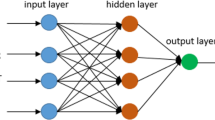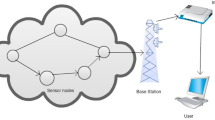Abstract
Data aggregation has been emerged as a basic approach in wireless sensor networks (WSNs) in order to reduce the number of transmissions of sensor nodes.This paper proposes an energy-efficient multi-source temporal data aggregation model called MSTDA in WSNs. In MSTDA model, a feature selection algorithm using particle swarm optimization (PSO) is presented to simplify the historical data source firstly. And then a data prediction algorithm based on improved BP neural network with PSO (PSO-BPNN) is proposed. This MSTDA model, which helps to find out potential laws according to historical data sets, is deployed at both the base station (BS) and the node. Only when the deviation between the actual and the predicted value at the node exceeds a certain threshold, the sampling value and new model are sent to BS. The experiments on the dataset which comes from the actual data collected from 54 sensors deployed in the Intel Berkeley Research lab made a satisfied performance. When the error threshold greater than 0.15, it can decrease more than 80% data transmissions.
Similar content being viewed by others
References
Akyildiz I. F., Su W., Sankarasubramaniam Y., Cayirci E. (2002) A survey on sensor networks. IEEE Communications Magazine 40(8): 102–105
Wang N.-C., Huang Y.-F., Chen J.-S., Yeh P.-C. (2007) Energy-aware data aggregation for grid-based wireless sensor networks with a mobile sink. Wireless Personal Communications 43(4): 1539–1551
Intanagonwiwat C., Govindan R., Estrin D. (2000) Directed diffusion: A scalable and robust communication paradigm for sensor networks. 6th Annual International Conference on Mobile Computing and Networking 8: 56–67
Heinzelman W. R., Chandrakasan A., Balakrishnan H. (2000) Energy-efficient communication protocol for wireless microsensor networks. The 33rd Annual Hawaii International Conference on System Siences 1: 3005–3014
Madden S., Franklin M. J., Hellerstein J. M., Hong W. (2002) TAG: A tiny AGgregation service for ad-hoc sensor networks. SIGOPS Oper. Syst. Rev 36(SI): 131–146
Sharaf M. A., Beaver J., Labrinidis A., Chrysanthis P. K. (2003) TiNA: A scheme for temporal coherency-aware in-network aggregation. Proceedings of the Third ACM International Workshop on Data Engineering for Wireless and Mobile Access 9: 69–76
Chu D., Deshpande A., Hellerstein J. M., Hong W. (2006) Approximate data collection in sensor networks using probabilistic models. 22nd International Conference on Data Engineering 4: 48–53
Anisi M. H., Rezazadeh J., Dehghan M. (2008) FEDA: Fault-tolerant energy-efficient data aggregation in wireless sensor networks. SoftCom 2008: 16th International Conference on Software, Telecommuncations and Computer Networks 9: 188–192
Ren S. Q., Park J. S. (2009) Fault-tolerance data aggregation for clustering wireless sensor network. Wireless Personal Communications 51(1): 179–192
Vapnik V. N. (2000) The nature of statistical learning theory. Springer Verlag, New York
Kennedy J., Eberhart R. (1995) Particle swarm optimization. IEEE International Conference On Neural Networks 4: 1942–1948
Ding C., Peng H. (2005) Minimum redundancy feature selection from microarray gene expression data. Journal of Bioinformatics and Computational Biology 3(2): 185–206
Takayama K., Fujikawa M., Nagai T. (1999) Artificial neural network as a novel method to optimize pharmaceutical formulations. Pharmaceutical research 16(1): 1–6
Fausett L. (1994) Fundamentals of neural networks: Architectures, algorithms, and applications. Prentice-Hall, Inc, Upper Saddle River, NJ, USA
UCI (2006-03). (1999). KDD Cup competition. http://kdd.ics.uci.edu/databases/kddcup99/kddcup99.html
Shi Y., Eberhart R. (1998) A modified particle swarm optimizer. IEEE International Conference of Evolutionary Computation 5: 69–73
Author information
Authors and Affiliations
Corresponding author
Rights and permissions
About this article
Cite this article
Guo, W., Xiong, N., Vasilakos, A.V. et al. Multi-Source Temporal Data Aggregation in Wireless Sensor Networks. Wireless Pers Commun 56, 359–370 (2011). https://doi.org/10.1007/s11277-010-9976-9
Published:
Issue Date:
DOI: https://doi.org/10.1007/s11277-010-9976-9




